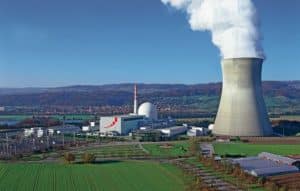Findings on fuel elements in Leibstadt NPP: ENSI is classifying the incident as INES 1 and checking the submitted measures
An inspection of fuel elements in Leibstadt NPP revealed that critical boiling states – so-called dryouts – had systematically occurred over several cycles. The Swiss Federal Nuclear Safety Inspectorate (ENSI) is classifying this incident as Level 1 on the International Nuclear and Radiological Event Scale (INES). It is currently checking the documents and actions submitted by KKL last week.
Following a comprehensive root cause analysis conducted in 2015, Leibstadt NPP discovered that fuel rod damage dating from 2014 is attributable to dryout. If dryout occurs, the fuel rods are no longer completely covered by a film of water, since the water has already vaporised into steam. Such “dry” areas become very hot and are therefore more oxidise more severily.
 Subsequently, Leibstadt NPP took measures to prevent such dryout occurring during the 2015/2016 cycle. However, inspection of the fuel elements as part of the 2016 annual outage once more revealed heavily oxidised areas on fuel rods caused by dryout.
Subsequently, Leibstadt NPP took measures to prevent such dryout occurring during the 2015/2016 cycle. However, inspection of the fuel elements as part of the 2016 annual outage once more revealed heavily oxidised areas on fuel rods caused by dryout.
The core of Leibstadt NPP consists of a total of 648 fuel elements, each with 91 or 96 fuel rods, depending upon the element type. The root cause analysis involved inspecting more than 200 fuel elements with nearly 20,000 fuel rods from different cycles. Findings were discovered on 47 fuel elements and it was established that dryout had obviously occurred after the 2012/2013 cycle. The findings are up to 26 cm in length. The fuel rods in Leibstadt are around 410 cm long.
No danger to the environment
The findings discovered on the fuel elements in 2016 did not lead to any release of radioactive materials into the cooling circuit and consequently no radiological limits were exceeded. Similarly, they did not cause the safety equipment to respond. However, overall, the safety implications of the incident are regarded as significant for the nuclear operation. For this reason, ENSI is classifying the systematic occurrence of dryout as Level 1 (Anomaly) on the International Nuclear and Radiological Event Scale.
In order for Leibstadt NPP to be allowed to start up again, the core loading and reactor operation must be such as to exclude dryout during normal operation, in the event of operational malfunctions and in accident categories 1 and 2 of the design basis accidents.
ENSI is checking documents
Mid-December, the nuclear power plant submitted a report and ENSI is currently checking it, together with further operating documents that have been submitted. ENSI is calling in various experts to assess the facts and is also involved in international exchanges on the subject. Moreover, ENSI has kept itself up-to-date with the work at Leibstadt NPP by means of inspections and dedicated technical discussions.
Additional requirements
Additional requirements imposed by ENSI over and above the direct guarantee of safe reactor operation:
- ENSI must be provided with a report on the suitability for disposal of fuel rods or fuel elements which have oxide layers that exceed the thickness specified for allowed burn-up. This report must include suitability for transport, interim storage and final disposal, as well as stating the quantity of rods or elements affected. (Deadline: Autumn 2017)
- In view of the described findings observed on several fuel elements in this incident, an independent, more detailed and cross-departmental analysis must be carried out, taking account of M&O aspects (HOF analysis). In particular, this must also take account of interfaces with external bodies and/or in-house departments. The results of the technical root cause analysis (technical RCA), which is being conducted as part of the BELDO project, should be included in or added to the required HOF analysis. The results are to be submitted to ENSI. (Deadline: Autumn 2017)
Other Swiss plants so far unaffected
Based on current knowledge, it is not yet possible to say whether this anomaly can also occur in other boiling water reactor facilities . So far, the inspection of fuel elements in Mühleberg NPP has not revealed any indication of increased oxidation of the fuel cans as a result of dryout.
Because of the difference in the way that Boiling Water Reactors and Pressurised Water Reactors operate, there is no transferability to the PWR plants – Gösgen and Beznau.

